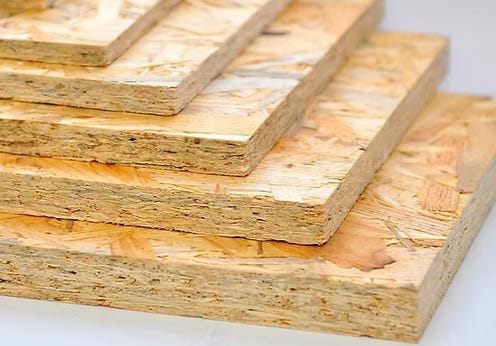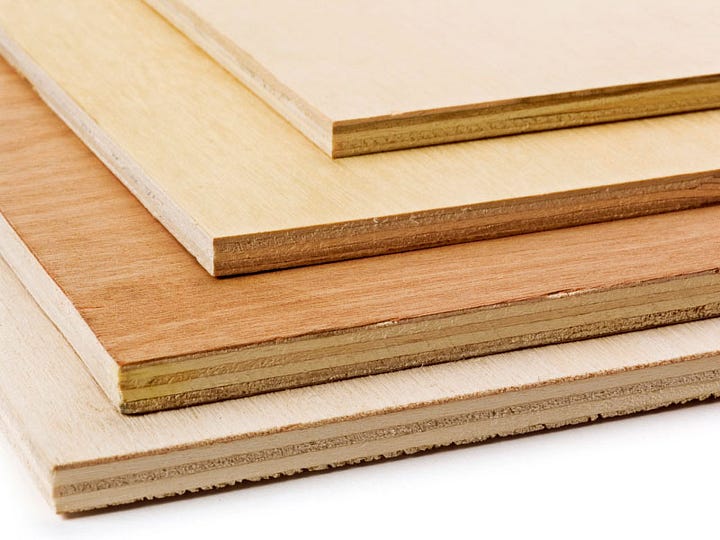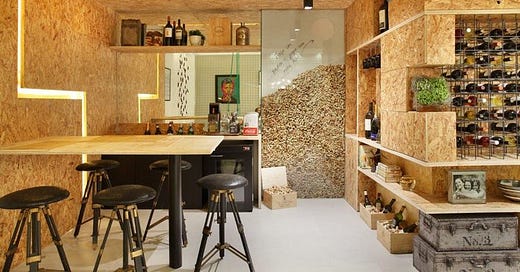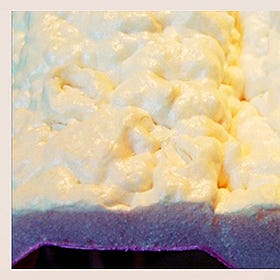Ever walked into a house with a sagging, swollen floor? Chances are, OSB was improperly installed as a sub-floor. Although OSB is a common, affordable material in construction, it can turn into an SOB if not handled correctly.
What is OSB?
Oriented Strand Board (OSB) is one of those materials you’ve definitely seen, even if you didn’t know what it was called. It’s the Frankenstein of wood—layers of strands arranged, glued, and pressed into a tough, affordable panel. Builders love it for its strength and price tag, often favoring it over plywood. To most people, it just looks like a patchwork of scraps and sparks the question: “How can something that looks like glued scraps actually work?” But behind OSB’s appearance is some high-level engineering.
Where did OSB come from?
OSB got its start in the 1960s thanks to an engineer named Armin Elmendorf Elmendorf wanted to create a more cost-effective alternative to traditional wood-based panels like plywood. He figured out a way to turn scrappy, knotty, and otherwise useless trees into an engineered wood panel that has many of the same characteristics of plywood. The result saves forests, cuts costs, and helps builders stretch their budgets further. This is genius until something goes wrong.
OSB’s Strengths
Affordable Muscle: OSB is cheaper than plywood and can deliver decent strength when used appropriately.
Tough Where It Counts: Its crisscrossed layers offer solid structural integrity, making it popular for roofing and subflooring. It also comes in larger-sized panels than plywood.
Eco-ish: By using fast-growing species and recycled wood scraps, OSB is a more sustainable option—on paper, at least.
Thermal performance: OSB has slightly better insulating properties compared to plywood, but plywood works just fine when paired with proper insulation.
The poison inside the panel
But there’s a darker side to OSB. Its strength comes not only from the wood strands but also from the adhesives that bond them together. Traditional glues, like urea-formaldehyde (UF), can off-gas harmful chemicals—PAHs (Polycyclic Aromatic Hydrocarbons) and VOCs (Volatile Organic Compounds) such as formaldehyde and benzene—that have been linked to cancer. Some manufacturers now use so-called "lower-emitting" resins like phenol-formaldehyde (PF) or isocyanate-based adhesives (MDI/PMDI), but these still carry their own health and environmental risks. The fact remains: when you poke a hole in OSB, you might be releasing these chemicals into your home. Plywood is made by gluing thin layers of wood together, and the glues used can also contain formaldehyde. However, some plywoods are made with phenol-formaldehyde, which off-gasses less formaldehyde than urea-formaldehyde.
One also has to consider where the plywood is made. Some imported plywood has been shown to have some of the highest levels of formaldehyde emissions, even though it is supposed to comply with U.S. regulations. If you're renovating or building, always check the labeling on materials to ensure they meet safety standards—especially regarding formaldehyde emissions. Though sometimes, even this isn't enough, as some of our safety regulations aren't very stringent.


OSB vs. Plywood – What authoritative sources say
Building codes treat OSB and plywood the same. According to the APA (The Engineered Wood Association), a trade organization that sets performance standards, both are listed as equal in their guidelines.
Strength: OSB is stronger than plywood in terms of shear strength (resistance to sliding). This is why OSB is often preferred for roofing, where shear strength is important. However its heaviness and density make it harder to handle and install. Nails and screws are more likely to stay in place in plywood vs OSB.
Moisture: All wood products expand when exposed to moisture, but OSB tends to expand faster around the edges. This is worse when is OSB made from certain trees that do not natural decay resistance compared to plywood. Plywood swells evenly when wet but dries quickly, returning to its original shape.
Moisture can be an enemy for OSB, especially if it’s left exposed to rain during construction or if it’s installed in high-humidity areas without proper sealing. OSB takes longer to get wet and dry, holding moisture longer, which can lead to faster degradation. Unlike plywood, OSB edges stay swollen even after drying, which is a major downside.
Fire-resistance: OSB burns hotter and faster than plywood due to the glues used in its manufacture, which can lead to faster structural failure in a fire.
Many problems with OSB arise from poor storage, improper installation, lack of ventilation, or failing to use a vapor barrier. If OSB is exposed to moisture during any of these stages, it can deteriorate much quicker.
“Our builders put OSB sheathing on the roof for our new build and within a few weeks it has started warping badly already (they didn't put a membrane over it so it's been out in the elements subject to the rain and the sun).” - From a Construction Forum
Manufacturers Specifications: Many manufacturers provide detailed guidelines on whether to use plywood, OSB, or another material, based on the intended application and environmental conditions. For example, OSB is generally not recommended as a subfloor for tile installations because moisture can cause it to swell unevenly, transferring stress to the tiles and potentially leading to failure. Similarly, while OSB may be used under vinyl flooring in some cases, it requires careful sealing and an appropriate underlayment to protect against moisture. Moreover, certain roofing and wall warranties specify the type of sheathing or subfloor required—using a material like OSB in situations where a higher-grade plywood is specified could void the warranty. Always consult the manufacturer's guidelines to ensure you’re using a material that meets the performance and warranty requirements.
Use cases
Roof sheathing:
Roof sheathing is a layer of material typically plywood or OSB installed over roof rafters to provide a stable base for roofing materials. Investing in more expensive plywood doesn’t always guarantee a better roof. OSB can be acceptable—but only if it’s properly sealed. OSB absorbs moisture readily, especially at the edges, which can lead to swelling, warping, and even mold growth. If you live in a rainy climate or if the panels might remain exposed during construction, plywood is generally a safer choice. Most issues with OSB arise when it sits in the elements for a while before the building is fully enclosed. On a budget? Use high-grade OSB and seal it thoroughly.
Wall sheathing:
Wall sheathing is a layer of material applied to a wall frame to provide structural support and a surface for attaching siding or cladding. For wall applications, OSB and plywood perform comparably. The choice may come down to availability, cost, or local building practices.
Subfloors:
While some people use OSB for subfloors, it can lead to squeaks caused by movement and friction at joints—especially if the boards dry out and shrink. OSB may also degrade or even turn to mush when exposed to moisture, becoming brittle over time causing soft floors. For a quiet floor, it’s best to stick with plywood. If OSB is used some installers use dry graphite lubricant or WD-40 between the joint to reduce squeaks but the latter can complicate refinishing.
High-Humidity Environments (Bathrooms, Saunas, etc.):
Standard OSB won’t hold up here. Unless it’s moisture-resistant OSB, it’ll degrade over time in humid conditions. And even with the latter, sealing is critical.
Heavy Load Surfaces:
While OSB is strong, it lacks the impact resistance of plywood. For surfaces that take regular abuse, like shop floors or workbenches, plywood is the safer bet.
Fine Woodworking or Decorative Projects:
OSB isn’t pretty. It has no grain worth showing off and is hard to paint so using it for cabinetry or walls is really a personal preference.
Cookie vs. granola bar
Before I finish, OSB is not to be confused with MDF (Medium Density Fiberboard). MDF (Medium-Density Fiberboard) is made from fine wood fibers and resin, resulting in a smooth, uniform surface ideal for painted or veneered indoor projects like cabinets and furniture—but it’s not very moisture-resistant. OSB is composed of larger wood strands bonded with resin, giving it a rough, textured appearance that’s strong and durable for structural uses though it’s less attractive for finish work.
Think of MDF as a smooth, pressed cookie (like shortbread): dense, uniform, and perfect when you want a smooth look. OSB, on the other hand, is more like a granola bar: chunky and rough, built for toughness rather than beauty.
The verdict
While OSB is an affordable and useful material, don't let it turn into an SOB
OSB is more affordable and works perfectly well for sheathing when it’s properly stored, sealed, installed, and covered—such as beneath siding or roofing—without prolonged exposure to moisture. For wood floors, plywood is recommended over OSB. When it comes to tile and other finishes, always check the manufacturer’s specifications.
Good quality plywood holds up better when the material is subject to being exposed, as it resists swelling, delamination, and UV damage more effectively.
If you’re sensitive to or concerned about chemical emissions, opt for plywood.
Lastly, always check the manufactures specifications for allowable materials for sheathing and sub-floors. For example, the floor manufacturer will have guidelines on acceptable sub-floors.
Thanks for reading! Feel free to drop a comment or share if you found this helpful.
For a refresher on isocyanates, check out the Grenfell article.
Grenfell Took Many Lives...Yet We Continue To Play With Fire
Most homeowners are unaware that the foams and plastics that caused large disasters are widely prevalent in homes. If you like the post, please support me by sharing it.
Queen’s Repository
When choosing between OSB and plywood, it’s not just about the material—it’s about picking the right grade for the job. While plywood is graded mostly by how it looks, OSB is judged by how it performs under certain conditions. Knowing the difference between these grades will help you select the right panel and avoid mistakes. Here’s a breakdown of how OSB and plywood are classified, starting with OSB.
OSB Grades:
OSB is typically graded by its intended use and exposure rating, rather than surface appearance like plywood. Here are the common OSB types:
OSB/1 – General-purpose boards, for interior use in dry conditions (furniture, packaging).
OSB/2 – Load-bearing boards for interior use in dry conditions.
OSB/3 – Load-bearing boards for use in humid conditions (most common for construction).
OSB/4 – Heavy-duty, load-bearing boards for use in humid and high-stress conditions.
In North America, you'll also see OSB labeled for its exposure:
Exposure 1 – Can withstand moisture temporarily (like if it rains before the roof goes on).
Exterior – It has special resins and treatments to survive outside indefinitely — it can handle constant outdoor exposure without falling apart or delaminating.
OSB typically lives behind something—under roofing, under siding, or under flooring—so the need for true exterior-rated OSB is rare. In contrast, plywood does have more exterior-rated varieties, like marine plywood, that are common for outdoor projects.
Plywood Grades:
Plywood gets a letter grading system for each face (front and back), based on appearance and defects:
A – Smooth, sanded, no visible defects. Best finish.
B – Solid surface, but may have minor repairs like plugs.
C – More visible defects, knots, or splits allowed.
D – Lower quality, larger knots and defects, usually for structural applications where appearance doesn’t matter.
Plywood is usually labeled like A-C or B-B, where the first letter is the front face and the second is the back.
CDX – One of the most common grades for construction; C face front, D back, X means exterior glue (not fully waterproof but weather-resistant).
Sanded plywood – Higher grade like A-C for visible surfaces.
Sheathing plywood – Lower grades like C-D, used for structural purposes where it gets covered (e.g., under siding or roofing).













I had no idea! Thanks for the education.